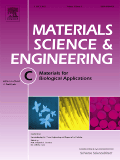
COLLOIDS AND SURFACES B-BIOINTERFACES
Scope & Guideline
Innovating Interactions for Tomorrow's Biotechnology
Introduction
Aims and Scopes
- Nanomedicine and Drug Delivery Systems:
Research that focuses on the development of nanocarriers for targeted and controlled drug delivery, utilizing materials such as liposomes, micelles, and nanoparticles to enhance therapeutic efficacy. - Biomaterials and Tissue Engineering:
Studies involving the design and application of biomaterials for tissue regeneration, including hydrogels and scaffolds that promote cell adhesion, proliferation, and differentiation. - Antimicrobial and Antibiofilm Strategies:
Investigations into the use of nanomaterials and surface modifications to develop antimicrobial coatings and strategies to prevent biofilm formation on medical devices. - Biointerfaces and Surface Modifications:
Exploration of the interactions at the biointerface, including the modification of surfaces to improve biocompatibility, functionality, and resistance to fouling. - Diagnostics and Biosensing Applications:
Research on the development of biosensors and diagnostic tools using nanomaterials for the detection of biomarkers in medical diagnostics.
Trending and Emerging
- Smart and Responsive Nanocarriers:
There is a growing emphasis on the development of smart nanocarriers that respond to environmental stimuli (e.g., pH, temperature) for controlled drug release, reflecting advancements in targeted therapy. - Biomimetic Strategies:
Research utilizing biomimetic approaches to create materials that closely mimic natural biological systems is on the rise, indicating a shift towards more innovative and effective therapeutic solutions. - Microfluidic Systems for Drug Delivery:
The application of microfluidics in the design and fabrication of drug delivery systems is trending, highlighting the importance of precise control over the release profiles and interactions with biological systems. - Nanoparticles in Combination Therapies:
An increase in studies exploring the use of nanoparticles in combination therapies, particularly in cancer treatment, is evident, showcasing the trend towards integrated treatment approaches that enhance therapeutic efficacy. - Environmental and Sustainable Nanotechnology:
Emerging research focuses on environmentally friendly and sustainable approaches to nanotechnology, including the synthesis of biodegradable nanomaterials and the application of green chemistry principles.
Declining or Waning
- Traditional Drug Formulations:
There has been a noticeable decrease in studies focusing on conventional drug formulations and their interactions with biological systems, as the trend shifts towards more advanced nanocarrier systems. - In Vitro Studies Without Translational Relevance:
Research that primarily focuses on preliminary in vitro studies without clear pathways to translational applications is becoming less common, as the journal emphasizes studies that demonstrate potential clinical relevance. - Single-Function Nanoparticles:
The publication of studies centered on single-function nanoparticles is declining, as there is a growing interest in multifunctional nanomaterials that offer synergistic effects in therapeutic applications. - Basic Physical Chemistry of Colloids:
While foundational studies in colloidal chemistry remain important, there has been a decrease in the frequency of publications that do not directly apply these principles to biological or biomedical contexts.
Similar Journals

Biomaterials Research
Unveiling the potential of biomaterials for healthcare.Biomaterials Research, published by the American Association for the Advancement of Science, is a prominent open access journal established in 2014, dedicated to advancing the field of biomaterials. Based in the United Kingdom, this journal has swiftly become an essential platform for researchers and practitioners, offering groundbreaking insights in biomaterials, biomedical engineering, ceramics and composites, and miscellaneous medical fields. With its impressive Q1 ranking across multiple relevant categories in 2023 and its strong Scopus rankings, including a remarkable 90th percentile in the medicine category, Biomaterials Research showcases high-quality, peer-reviewed research designed to address both practical and theoretical challenges in biomaterials science. As an open access journal, it promotes wider dissemination and accessibility of research findings, crucial for fostering innovation and collaboration within the scientific community. Researchers, professionals, and students alike are encouraged to contribute, read, and engage with the latest developments in this dynamic field.

Biofabrication
Exploring Breakthroughs in Biofabrication Research.Biofabrication, published by IOP Publishing Ltd, stands at the forefront of the interdisciplinary fields of biochemistry, bioengineering, biomaterials, biomedical engineering, biotechnology, and miscellaneous medicine. Since its inception in 2009, this prestigious journal has secured its position within the Q1 category across multiple disciplines as of 2023, reflecting its high impact and significant contribution to advancing research in these domains. With ranks such as #19 in biochemistry and #10 in biomaterials according to Scopus, it showcases groundbreaking studies and innovative methodologies that are crucial for the evolution of biofabrication technologies. Authored by leading researchers and professionals, the journal publishes articles that explore the synthesis, characterization, and application of biomaterials, providing valuable insights for both academic researchers and industry practitioners. The impact factor of the journal, combined with its rigorous peer-review process, guarantees high-quality content that pushes the boundaries of knowledge and technology. Researchers and students engaged in these dynamic fields will find Biofabrication an indispensable resource for staying abreast of critical developments and emerging trends.

Progress in Biomaterials
Empowering Interdisciplinary Collaboration in BiomaterialsProgress in Biomaterials is a premier journal published by Springer Heidelberg, dedicated to advancing the field of biomaterials through the dissemination of high-quality research articles, reviews, and case studies. The journal, with an ISSN of 2194-0509 and an E-ISSN of 2194-0517, holds an esteemed position within both the Biomaterials and Chemical Engineering fields, as evidenced by its rankings in the Q2 and Q1 quartiles, respectively. With its convergence over the years from 2013 to 2023, it has maintained a strong impact on scientific discourse, ranking #15 in Chemical Engineering and #30 in Biomaterials according to Scopus metrics. The journal is based in Heidelberg, Germany, and aims to provide an open platform for interdisciplinary collaboration amongst researchers, professionals, and students alike, fostering innovation and progress in biomaterials research. As a crucial resource for those engaged in this dynamic field, it empowers authors and readers to explore the latest trends, technologies, and applications in biomaterials development.

Nanotechnology Science and Applications
Pioneering Discoveries in Nanotechnology and Biomedical Engineering.Nanotechnology Science and Applications, published by DOVE MEDICAL PRESS LTD, is a premier open-access journal dedicated to advancing knowledge in the fields of nanoscience and nanotechnology, particularly focusing on their applications in bioengineering, biomedical engineering, and pharmaceutical sciences. Since its inception in 2008, this journal has provided a platform for the dissemination of high-quality research that is rigorously peer-reviewed, ensuring that only the most impactful findings reach a global audience. With an impressive impact factor reflected in its recent categorization in the Q1 tier for Pharmaceutical Science and Q2 for Bioengineering and Nanoscience, it stands as a critical resource for researchers, practitioners, and students eager to explore the cutting-edge innovations within these rapidly evolving disciplines. The journal's commitment to accessibility and its robust indexing in Scopus—ranked highly in its respective categories—reinforces its importance as a leading forum for the exchange of scientific knowledge and the fostering of collaborative research in nanotechnology applications.

JOURNAL OF BIOMEDICAL MATERIALS RESEARCH PART B-APPLIED BIOMATERIALS
Exploring New Horizons in Applied BiomaterialsJOURNAL OF BIOMEDICAL MATERIALS RESEARCH PART B-APPLIED BIOMATERIALS, published by Wiley, is a leading journal in the field of biomaterials and biomedical engineering, with an impact factor reflected in its relevant Scopus rankings—including a Q2 position in Biomedical Engineering and Q3 in Biomaterials for 2023. This journal, with ISSN 1552-4973 and E-ISSN 1552-4981, serves as a vital platform for disseminating pioneering research and innovative applications of biomaterials. Positioned in the United States, it aims to bridge the gap between material science and biological applications, fostering collaboration among researchers, professionals, and students dedicated to advancing technology in healthcare. With a convergence of studies from 2003 to 2024 and a growing focus on open access, the journal ensures greater visibility and accessibility for groundbreaking research. Join us in exploring the dynamic field of biomaterials, as we push the boundaries of science and engineering for improved patient outcomes.

Materials Science & Engineering C-Materials for Biological Applications
Empowering discoveries in materials for biological innovation.Materials Science & Engineering C-Materials for Biological Applications is a premier journal published by ELSEVIER, dedicated to advancing the field of biomaterials through interdisciplinary research. With a robust ISSN of 0928-4931, this journal has made its mark in the realms of Chemical Engineering and Materials Science, achieving impressive Scopus rankings within its categories, namely Rank #16/151 in Bioengineering (89th percentile) and Rank #13/112 in Biomaterials (88th percentile). Although the journal's coverage in Scopus has been discontinued since 2021, it remains a critical resource for researchers, professionals, and students eager to explore innovative materials and their applications in biological contexts. The journal’s open access policy enhances its accessibility, fostering a global exchange of knowledge and inspiring future advancements in the field of materials science.

Bioengineering-Basel
Driving Excellence in Bioengineering ResearchBioengineering-Basel, an esteemed journal published by MDPI, stands at the forefront of innovation in the field of bioengineering since its inception in 2014. With an E-ISSN of 2306-5354, this fully Open Access journal based in Switzerland provides a platform for researchers and professionals to disseminate cutting-edge findings across various aspects of bioengineering, including biomaterials, tissue engineering, and biopharmaceuticals. The journal has been recognized with a Q3 ranking in the 2023 Bioengineering category, reflecting its commitment to quality and relevance. By facilitating widespread accessibility to academic knowledge, Bioengineering-Basel aims to foster collaboration and stimulate thought leadership within the global research community, making it an indispensable resource for students, scholars, and industry practitioners alike.

JOURNAL OF MATERIALS SCIENCE-MATERIALS IN MEDICINE
Unleashing the Potential of Materials in Medical ApplicationsJOURNAL OF MATERIALS SCIENCE-MATERIALS IN MEDICINE is a leading peer-reviewed journal published by Springer, dedicated to advancing the field of biomedical materials science. With an ISSN of 0957-4530 and E-ISSN 1573-4838, this Open Access journal has been committed to providing researchers and professionals with freely accessible, high-quality research since 2021. It features an extensive scope spanning bioengineering, biomaterials, biomedical engineering, and biophysics, reflecting its significant impact within these interdisciplinary domains. Recognized within the Q2 category of the 2023 rankings in multiple fields, the journal proudly positions itself as a crucial resource for innovative materials that contribute to advancements in medical applications. With impressive Scopus rankings, including 26th in Biophysics and 40th in Materials Science for Biomaterials, researchers, students, and industry professionals alike can rely on this publication for cutting-edge insights that drive the future of medical materials and technologies. Based in Dordrecht, Netherlands, the journal provides a vibrant platform for sharing groundbreaking discoveries and fostering collaborative research among a global audience.

JOURNAL OF BIOMATERIALS APPLICATIONS
Advancing the frontier of biomaterials research.JOURNAL OF BIOMATERIALS APPLICATIONS, published by SAGE PUBLICATIONS LTD, serves as a pivotal platform for the dissemination of cutting-edge research in the field of biomaterials and biomedical engineering. With an ISSN of 0885-3282 and an E-ISSN of 1530-8022, this journal has been a respected venue for scholarly communication since its inception in 1986. Aiming to provide comprehensive insights into the applications of biomaterials, this journal publishes high-quality articles that explore innovative materials and methodologies, thereby fostering advancements in medical technology and tissue engineering. The journal consistently ranks in the third quartile (Q3) for both Biomaterials and Biomedical Engineering categories, strengthening its position among the noteworthy academic resources available today. With a dedicated readership comprising researchers, industry professionals, and students, JOURNAL OF BIOMATERIALS APPLICATIONS plays a vital role in supporting knowledge exchange and scientific progress within these dynamic fields.

COLLOIDS AND SURFACES A-PHYSICOCHEMICAL AND ENGINEERING ASPECTS
Fostering Excellence in Physicochemical EngineeringCOLLOIDS AND SURFACES A-PHYSICOCHEMICAL AND ENGINEERING ASPECTS is a prestigious journal published by Elsevier, focusing on the interdisciplinary domains of colloid and surface chemistry, physical and theoretical chemistry, and engineering aspects. With an impressive impact factor and consistently high rankings—Q2 in Colloid and Surface Chemistry, and Q1 in both Physical and Theoretical Chemistry as well as Surfaces and Interfaces—it stands as a vital resource for researchers and professionals seeking to advance their understanding in these critical areas of study. Established in 1993, the journal spans over three decades of publication, gathering robust interdisciplinary insights that cater to both fundamental research and practical applications. While the journal is not currently open access, it remains an essential platform for disseminating innovative studies that explore the physicochemical properties of colloidal systems and surface interactions. Based in the Netherlands, the journal actively encourages contributions that enhance the scientific community’s knowledge and application of these complex phenomena, making it an indispensable tool for students and professionals alike in their quest for cutting-edge advancements.